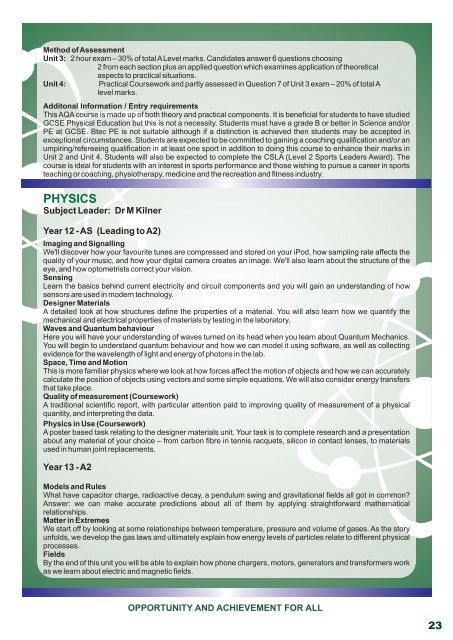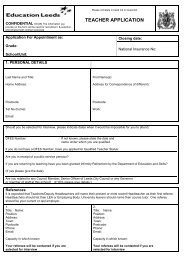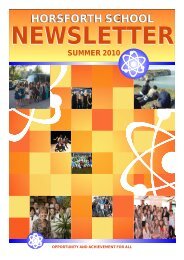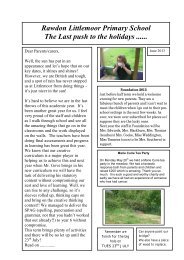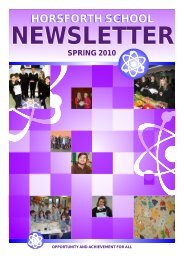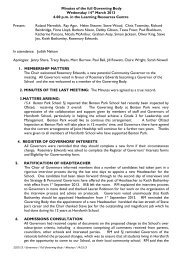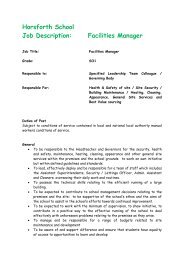POST-16 PROSPECTUS UPDATE SEP 11.cdr
POST-16 PROSPECTUS UPDATE SEP 11.cdr
POST-16 PROSPECTUS UPDATE SEP 11.cdr
Create successful ePaper yourself
Turn your PDF publications into a flip-book with our unique Google optimized e-Paper software.
Method of Assessment<br />
Unit 3: 2 hour exam – 30% of total A Level marks. Candidates answer 6 questions choosing<br />
2 from each section plus an applied question which examines application of theoretical<br />
aspects to practical situations.<br />
Unit 4: Practical Coursework and partly assessed in Question 7 of Unit 3 exam – 20% of total A<br />
level marks.<br />
Additonal Information / Entry requirements<br />
This AQA course is made up of both theory and practical components. It is beneficial for students to have studied<br />
GCSE Physical Education but this is not a necessity. Students must have a grade B or better in Science and/or<br />
PE at GCSE. Btec PE is not suitable although if a distinction is achieved then students may be accepted in<br />
exceptional circumstances. Students are expected to be committed to gaining a coaching qualification and/or an<br />
umpiring/refereeing qualification in at least one sport in addition to doing this course to enhance their marks in<br />
Unit 2 and Unit 4. Students will also be expected to complete the CSLA (Level 2 Sports Leaders Award). The<br />
course is ideal for students with an interest in sports performance and those wishing to pursue a career in sports<br />
teaching or coaching, physiotherapy, medicine and the recreation and fitness industry.<br />
PHYSICS<br />
Subject Leader: Dr M Kilner<br />
Year 12 - AS (Leading to A2)<br />
Imaging and Signalling<br />
We'll discover how your favourite tunes are compressed and stored on your iPod, how sampling rate affects the<br />
quality of your music, and how your digital camera creates an image. We'll also learn about the structure of the<br />
eye, and how optometrists correct your vision.<br />
Sensing<br />
Learn the basics behind current electricity and circuit components and you will gain an understanding of how<br />
sensors are used in modern technology.<br />
Designer Materials<br />
A detailed look at how structures define the properties of a material. You will also learn how we quantify the<br />
mechanical and electrical properties of materials by testing in the laboratory.<br />
Waves and Quantum behaviour<br />
Here you will have your understanding of waves turned on its head when you learn about Quantum Mechanics.<br />
You will begin to understand quantum behaviour and how we can model it using software, as well as collecting<br />
evidence for the wavelength of light and energy of photons in the lab.<br />
Space, Time and Motion<br />
This is more familiar physics where we look at how forces affect the motion of objects and how we can accurately<br />
calculate the position of objects using vectors and some simple equations. We will also consider energy transfers<br />
that take place.<br />
Quality of measurement (Coursework)<br />
A traditional scientific report, with particular attention paid to improving quality of measurement of a physical<br />
quantity, and interpreting the data.<br />
Physics in Use (Coursework)<br />
A poster based task relating to the designer materials unit. Your task is to complete research and a presentation<br />
about any material of your choice – from carbon fibre in tennis racquets, silicon in contact lenses, to materials<br />
used in human joint replacements.<br />
Year 13 - A2<br />
Models and Rules<br />
What have capacitor charge, radioactive decay, a pendulum swing and gravitational fields all got in common?<br />
Answer: we can make accurate predictions about all of them by applying straightforward mathematical<br />
relationships.<br />
Matter in Extremes<br />
We start off by looking at some relationships between temperature, pressure and volume of gases. As the story<br />
unfolds, we develop the gas laws and ultimately explain how energy levels of particles relate to different physical<br />
processes.<br />
Fields<br />
By the end of this unit you will be able to explain how phone chargers, motors, generators and transformers work<br />
as we learn about electric and magnetic fields.<br />
OPPORTUNITY AND ACHIEVEMENT FOR ALL<br />
23


